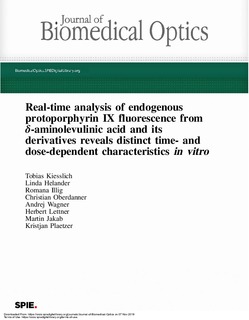| dc.contributor.author | Kiesslich, Tobias | |
| dc.contributor.author | Helander, Linda | |
| dc.contributor.author | Illig, Romana | |
| dc.contributor.author | Oberdanner, Christian | |
| dc.contributor.author | Wagner, Andrej | |
| dc.contributor.author | Lettner, Herbert | |
| dc.contributor.author | Jakab, Martin | |
| dc.contributor.author | Plaetzer, Kristjan | |
| dc.date.accessioned | 2019-11-08T08:26:56Z | |
| dc.date.available | 2019-11-08T08:26:56Z | |
| dc.date.created | 2014-09-14T16:08:46Z | |
| dc.date.issued | 2014 | |
| dc.identifier.issn | 1083-3668 | |
| dc.identifier.uri | http://hdl.handle.net/11250/2627315 | |
| dc.description.abstract | Abstract. Photodynamic therapy (PDT) and photodiagnosis based on the intracellular production of the photosensitizer protoporphyrin IX (PPIX) by administration of its metabolic precursor δ-aminolevulinic acid (ALA) achieved their breakthrough upon the clinical approval of MAL (ALA methyl ester) and HAL (ALA hexyl ester). For newly developed ALA derivatives or application in new tumor types, in vitro determination of PPIX formation involves multiparametric experiments covering variable pro-drug concentrations, medium composition, time points of analysis, and cell type(s). This study uses a fluorescence microplate reader with a built-in temperature and atmosphere control to investigate the high-resolution long-term kinetics (72 h) of cellular PPIX fueled by administration of either ALA, MAL, or HAL for each 10 different concentrations. For simultaneous proliferation correction, A431 cells were stably transfected with green fluorescent protein. The results indicate that the peak PPIX level is a function of both, incubation concentration and period: maximal PPIX is generated with 1 to 2-mM ALA/MAL or 0.125-mM HAL; also, the PPIX peak shifts to longer incubation periods with increasing pro-drug concentrations. The results underline the need for detailed temporal analysis of PPIX formation to optimize ALA (derivative)-based PDT or photodiagnosis and highlight the value of environment-controlled microplate readers for automated in vitro analysis. | nb_NO |
| dc.language.iso | eng | nb_NO |
| dc.publisher | Society of Photo-optical Instrumentation Engineers (SPIE) | nb_NO |
| dc.title | Real-time analysis of endogenous protoporphyrin IX fluorescence from δ-aminolevulinic acid and its derivatives reveals distinct time- and dose-dependent characteristics in vitro | nb_NO |
| dc.type | Journal article | nb_NO |
| dc.type | Peer reviewed | nb_NO |
| dc.description.version | publishedVersion | nb_NO |
| dc.source.volume | 19:085007 | nb_NO |
| dc.source.journal | Journal of Biomedical Optics | nb_NO |
| dc.source.issue | 8 | nb_NO |
| dc.identifier.doi | 10.1117/1.JBO.19.8.085007 | |
| dc.identifier.cristin | 1154279 | |
| dc.description.localcode | Open Access | nb_NO |
| cristin.unitcode | 194,65,15,0 | |
| cristin.unitname | Institutt for klinisk og molekylær medisin | |
| cristin.ispublished | true | |
| cristin.fulltext | original | |
| cristin.qualitycode | 2 | |
